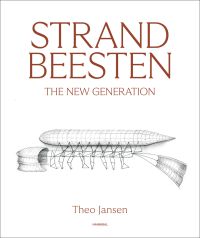
Strandbeesten – Kunstmuseum Den Haag, the Netherlands
26 Feb — 3 Jul 2022
Impressive skeletal structures that move independently, powered by the wind: artist Theo Jansen’s (b. 1948) strandbeesten, or beach animals, can regularly be seen wandering along the Dutch coast. They have been shown all round the world, too. As well as admiring Animaris Omnia, which has hung in Kunstmuseum Den Haag’s Garden Gallery since 2018, from 26 February visitors will be able to follow the evolution of these creatures in chronological order in our Projects Gallery and beside the lake in front of the museum. ’I’ve been making new forms of life since 1990’, Jansen says. ‘The basic material is not protein, as in nature, but electrical tubing. My strandbeests get their energy from the wind, so they don’t need to eat. They have evolved over time, as can be seen in the different generations. This will be clearly visible in the presentation at Kunstmuseum Den Haag.’
What better place than his hometown, with its ties to the sea, could Jansen have chosen to show how his strandbeests have evolved? In this exhibition at Kunstmuseum Den Haag fans will have an opportunity to get to know Jansen’s work better, and a larger audience will also get the chance to discover his work. ‘Displaying ten strandbeests outside will allow us to surprise a lot of people’, says director Benno Tempel. ‘I’m sure that everyone, young and old, will be fascinated by them, and inspired to come and see the exhibition in our Projects Gallery, where they can learn more about Jansen’s vision, techniques, background and process.’
Strandbeests are more than simply art objects. Jansen tries to create actual life, with the ultimate goal of releasing his creations to live an independent life in large herds on the beach. He realises this will not be possible in the near future, but he explained his dream a few years ago in an interview with National Geographic: ‘Give me a few million years and my strandbeests will live completely independently’. Over the past few decades Jansen has continually developed the creatures, gradually making them more independent. There are now twelve generations, he says. His first creation was not mobile, and was made of PVC tubing and sticky tape, but nowadays his creatures are imposing beasts, several metres long, that move around the beach independently. They are still made of tubing, but all kinds of ingenious techniques allow them to harness the energy of the wind which they use to walk around independently, move sand and flap their wings. A ‘stomach’ made of plastic bottles can capture and release wind, allowing them to move.
Jansen first created his strandbeests with a particular purpose in mind. They were intended as a solution to a problem that is still topical today: climate change. He wrote a newspaper article about the danger of sea-level rise, and he put forward a solution: animals made of electrical tubing that would churn up the beach and blow the sand onto the dunes to reinforce them. He then followed up by actually making the creatures, and he has never stopped since. Each new species was given a Latin name – Animaris Vulgaris, Animaris Rhinoceros, Mater Extensa – and Jansen has now divided the evolution of his strandbeests into twelve periods, based on various characteristics. In the most recent period, the ‘Volantum’ (2020-2021), he has even developed a strandbeest that flies. On his website strandbeest.com there is a detailed family tree dividing all the species into the different periods.
Please log-in or create an account to see your recent items.